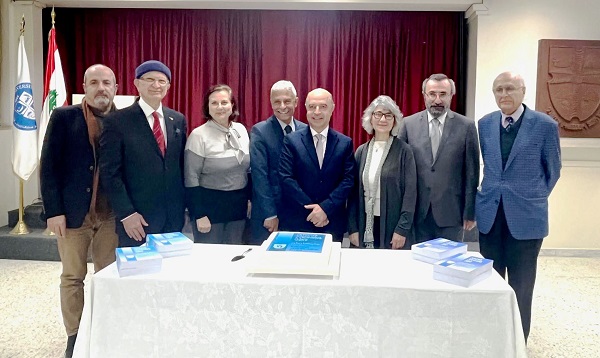
On January 19, the two books of the 42nd volume of the Haigazian Armenological Review were launched in the auditorium of the university, in the presence of Haigazian University President Rev. Dr. Paul Haidostian, Diaspora member of the National Academy of Sciences of the Republic of Armenia, historian and Honorary Doctor Zaven Messerlian, Rev. Nishan Bakalian, Seminarians of the Mekhitarist Congregation, the editorial board of the Review, and a number of book loving Lebanese Armenian individuals.
Dr. Armen Urneshlian, welcomed the public and asked for a moment of silence, honoring the memory of ex-member of the editorial board and advisory committee, Hon. Dr. Jirayr Tanielian. Dr. Urneshlian noted that starting with the 42nd volume the review will launch two books annually and numerated the novelties the 22nd volume had, namely, the mission statement, the colophon at the end of the 2nd book, and the interview section pertaining to a current critical concern of Armenian Studies, that involved four scientists/experts of the said critical issue.
Mrs. Silva Papazian, member of the editorial board, read the message of Dr. Hagop Cholakian, due to the latter’s absence. Dr. Cholakian considered the Haigazian Armenological Review “the only currently published Armenian Studies periodical in the Diaspora that prints the research papers in classical Armenian dictation. This is important from the perspective of maintaining the Western Armenian legacy of Armenian Studies.” Dr. Cholakian raised a number of issues concerning the use of foreign languages in disseminating Armenological materials, soliciting non-Armenian scholars, collaborating and cooperating with other Armenian Studies centers in the Diaspora, numerated the plurality of the areas of the papers published, like history, literary criticism, linguistics, economics, arts and crafts, sociology, church history and philosophy, ethnography and folklore. He found the publication of hitherto unpublished documents extremely important and emphasized the necessity of shedding light on different aspects of the Armenian Diaspora. He found that one of the unique points of the Review was the obituary section dedicated to scholars of Armenian Studies who had passed away the previous year. Dr. Cholakian appreciated as well the summaries of the contributors published in each volume.
Dr. Antranik Dakessian, editor in chief of the HAR, stressed that the Review has been instrumental in redefining the sphere of Armenian Studies and expanding it beyond the classical definitions of philology, linguistics and historiography. Dr. Dakessian stressed that papers pertaining to current issues as well as other fields of humanities are welcome and have been flowing in quite systematically. Eventually he called on the scholars to come out of self-deceptive comfort zones and act according to redefined concepts.
In his closing words, focused on the necessity of working hard in the schools “in order to have vigorous young generations who would do extra efforts towards their growth, and development” and called on generating more Armenian-related research articles in diverse languages and offer them abundantly on the social and academic media.
Dr. Haidostian noted that there are several examples of Armenian setbacks, however, “we also need to acknowledge the successes Armenians are having throughout the world, which boost our morale and determination.” He hailed “the besieged Review contributors of Artsakh, and all the other scholars of Armenian Studies who are toiling alone or in research centers”, he remembered the passing away of Dr. Tanielian, thanked the editorial board of the Review and all the contributors and wished to meet and celebrate “in 2023 with renewed vision and effort on the occasion of the to-be-published two books of volume 43”.
The two books of the 42nd volume of the Haigazian Armenological Review include 67 research papers, scrutiny articles, briefings, unpublished materials, book reviews and some 30 obituaries. The contributors of the two books come from Argentina, Armenia, Czechoslovakia, Egypt, Greece, Syria, Lebanon, Turkey, and the United States.
The pdf version of the books and all the previous volumes of the Review can be accessed on the websites of the National Library of Armenia, the National Academy of Sciences Library of the Republic of Armenia, as well as the Haigazian University.